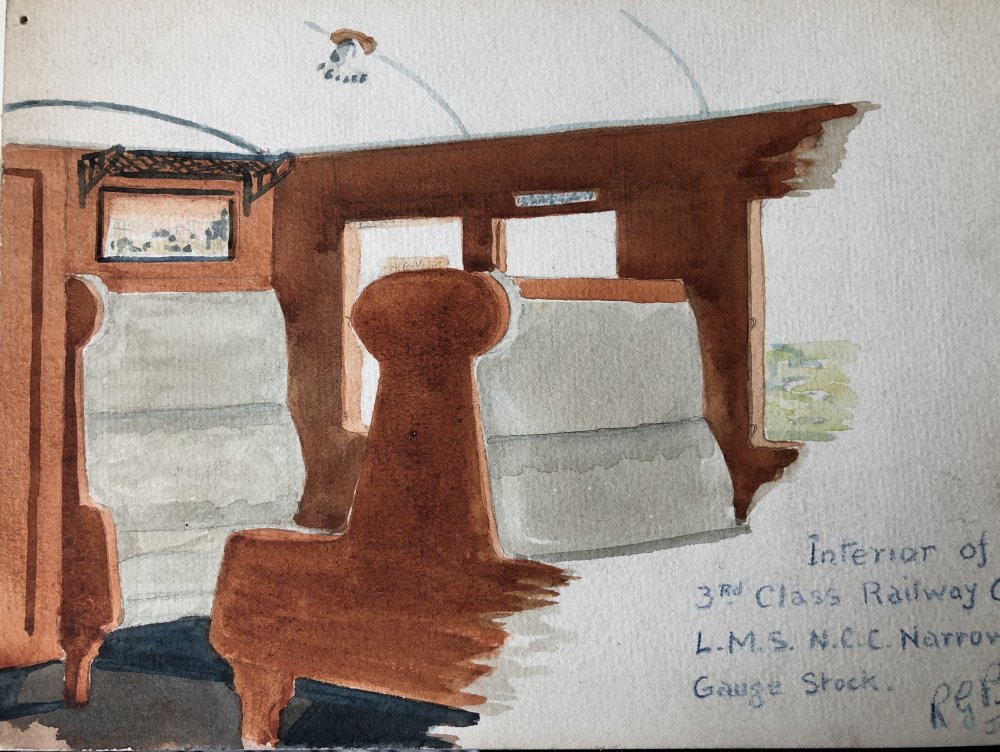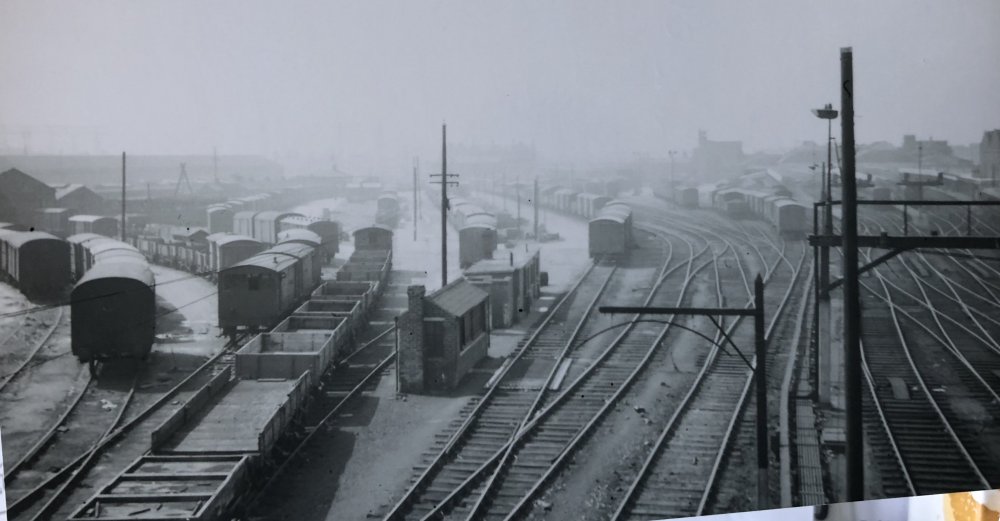-
Posts
15,834 -
Joined
-
Last visited
-
Days Won
393
Content Type
Profiles
Forums
Events
Gallery
Blogs
Store
Community Map
Everything posted by jhb171achill
-
That one seems to have never acquired UTA livery, unlike 44 (which looked very well with the UTA lining; latterly, the NCC painted narrow gauge engines plain black with no lining, but still an LMS crest...). Very handsome engines......
-
Yes, absolutely - it shows the light fittings even! I assume the upholstery colour is right, though I have no information on NCC upholstery ever being grey - but who knows!
-
This is a watercolour painting of the interior of one of the Ballymena & Larne bogies, done when it was on the NCC’s Ballycastle line. I remember travelling in main line ex-NCC stock which still had the exact same shaped wooden seat ends and panelling.....so this was very much as standard NCC fare internally as it was externally. I might add that I do not know the identity of the artist - nor did Senior; someone gave it to him years ago. Having travelled in those things himself, he said it was accurate.
-
The passenger trains ended in 1930, and even when it opened it had initially been goods-only. There was only a full service some 25-30 years. When Senior travelled on it, I believe he said that it was lifted beyond Rathkenny or Cargan, and while I cannot remember i got the impression he was on one of the older, smaller locomotives. he said the track was, by that stage, very bad and very overgrown. Even between 1930 and closure, it seems that traffic was not regular, and certainly not frequent. The NCC seems to have operated it more or less as a siding from Ballymena, with little traffic other than occasional visits to a dairy up there somewhere to collect a wagon full of churns. Senior got the impression that what little remaining iron ore traffic there was had ended years earlier. Technically the line closed in 1937, but he was there a few years later at which time the dairy traffic was (a) probably unofficial, and (b) very rare.
-
Price-wise that would seem about right. Weren't they something like £295 new? I think eBay have some sort of follow-up policy, like dispute resolution or something......... ghastly to hear of your misfortune with them, Tony.
-
At that time, catering vehicles with serving hatches locked up were even regular features on Dundalk - Dublin locals. I travelled in one such - not exactly sure of when, but I'd say about 1987/9. And yes, lack of availability of anything with seats in it was the reason.
-
Early 20th Century Branch Line Rail
jhb171achill replied to 2996 Victor's question in Questions & Answers
Just seeing this now - yes, spiked flat-bottom on half-round sleepers to start with. During 1900-05, extensive relaying took place and the half-round sleepers were only to be found in sidings afterwards. Also, rails directly spiked to sleepers were gradually soleplated by degrees from now on, except on lightly used sidings. I can remember seeing spiked FB rail on remoter sidings well into the 1970s, -
JM Design rtr GSR/Ranks Bulk Grain and Irish Standard Open Wagons
jhb171achill replied to Mayner's topic in News
Well, I finished the port last night! Must get more tomorrow! -
JM Design rtr GSR/Ranks Bulk Grain and Irish Standard Open Wagons
jhb171achill replied to Mayner's topic in News
Droooooooool..........................it's been a while............................. -
JM Design rtr GSR/Ranks Bulk Grain and Irish Standard Open Wagons
jhb171achill replied to Mayner's topic in News
I'm not sure. From what I recall, this system of classification only came in during CIE times in the 1950s. This would have been after any soft-tops had been built new. As far as I remember, the classifications only applied to standard CIE types of wagon. I will try to find where I have the list. Failing that, I know who I can ask! -
JM Design rtr GSR/Ranks Bulk Grain and Irish Standard Open Wagons
jhb171achill replied to Mayner's topic in News
Correct, that's exactly what the codes were for. I think I posted a list of them all in the distant past. The uniquely Irish "convertible vans" with the tarpaulin over a central roof opening - virtually all railways on this island had them - were known to railway men as "soft-tops". -
Absolutely superb stuff, Flange! many thanks. Must look and see what other Irish stuff they have! One of jhb171Snrx2's horizontal-planked goods vans to the left of it.........
-
Noticed this in a 1939 GSR public timetable (I normally look up WTTs!). Does anyone know anything about it? I was unaware of this system. When did it start or finish?
-
- 1
-

-
Three at least were painted green with grey roof and black chassis, specifically for use carrying mail between Cork and Tralee. They were tagged onto the back of passenger trains. This seems to have been reasonably short-lived, as they were repainted grey later, and must have been built that way. Somewhere in the back of my mind is an idea that four were so treated, but certainly three anyway. I have a note of at least one of their numbers somewhere, must search.
-
JM Design rtr GSR/Ranks Bulk Grain and Irish Standard Open Wagons
jhb171achill replied to Mayner's topic in News
No - I had a look. I’ll post a pic of it tomorrow or the next day. -
JM Design rtr GSR/Ranks Bulk Grain and Irish Standard Open Wagons
jhb171achill replied to Mayner's topic in News
Ah - so 00 gauge, not 0. Some of the "Castle" models will be going on display in due course at the new place, but obviously the main emphasis at the moment is to get all of Fry's stuff displayed. There is now agreement to make more display cabinets so that his British (mostly LNWR) and mainland European stuff can also be displayed. We'll see what space there is after that! Some of the "Castle" models will be loaned out to other locations for display in the meantime, so that as much as possible may be seen by the public. Among Fry's stuff are a small number of items he owned and operated, but didn't make himself. There is a six-car 1930s express diesel railcar set made by Lionel, but painted by Fry in Union Pacific colours - a beauty! Given that he repainted it, I wonder what its original appearance was like - anyone know? He made a model of a Swedish steam tram loco, a Norwegian sleeping car....I could go on. -
JM Design rtr GSR/Ranks Bulk Grain and Irish Standard Open Wagons
jhb171achill replied to Mayner's topic in News
I wonder if that is the compound now among the stored Malahide Castle models? There's a rake of matching GNR coaches with them too. There's also a rake of bubbles. And I wonder what became of the rest of those models? -
I'd love to know what the two wagons are at the bottom left - a six-wheel carriage truck presumably and some sort of flat........
-
Folks I am in the process of packing a large number of models into airtight plastic boxes for transport. Has anyone any idea where I might get inexpensive foam sheet - ideally of the sort you see in professional photographer's camera bags to hold lenses and so on, each hole carefully cut to the shape and size of what is going to go into it? I would need enough to pack about 100 x "0" gauge models. Thanks
-
Patrick, that is absolutely TOP class - superb stuff altogether.
-
Ha! You’re 100 right, of course; I should have cropped out the brown vans! Shows how extensive the place was....
-
Over seven years of dealing with tourists in the very same wisht Ciarraí, I never thought I'd say it, as I have always struggled to deal with ANY heavy accents, but I am pleasantly surprised to find that I kin undershtinnd that accent perfectly, boi.
-
-
JM Design rtr GSR/Ranks Bulk Grain and Irish Standard Open Wagons
jhb171achill replied to Mayner's topic in News
I don't know for certain, but I suspect before steam ended, as the only pictures I've ever seen of these things after 1960 are in grey. At a very wild guess I would be inclined to say GSR all-grey up to late 1940s, then red with "Ranks", then maybe grey with "Ranks" in the mid to late 1950s - and then grey with the various "snail" variations until the mid 60s, when "roundels" replace the "snails". It is possible that red with "Ranks" and grey with the same were concurrent, or that the grey came before AND after the red. It would be useful if anyone could throw any more light on this. The odd badly faded grey wagon with "Ranks" was still to be seen just after 1970. -
Good to see you here again, Nelson, and congratulations on finishing your course. I wish you the very best of luck with your job applications.
.png.c363cdf5c3fb7955cd92a55eb6dbbae0.png)



